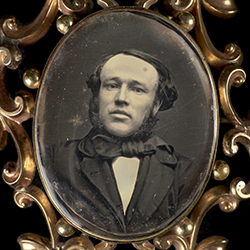Photographic Collection: Photo Jewellery 19th Century, Various photographers.

The Photo Jewellery collection held at the John Rylands Research Institute and Library is an interesting, thought provoking insight into culture and identity. Photography was an invention of the Victorian era and photographic jewellery represented a permanent way to store a memory and carry an image of beloved friends and family. Since the opportunity to be photographed was not as prevalent as it is today, a photograph was a special and precious object.
Small photographic portraits could be worn on silk or velvet ribbons around the neck, as brooches, rings, bracelets, in lockets, cufflinks and pocket watches. Often the photographs were mounted onto gold, silver or non-precious metals and set under glass and celluloid covers for protection. Portrait jewellery was a sentimental favourite, a place to hold a memory within a jewelled capsule to be carried or worn, kept close to the heart or placed discretely in a pocket or simply held in the palm of a hand. An engraved notation relating to specific dates and love messages was sometimes used as a personal touch.
The simple act of looking and assessing a face from a photograph enables us to consider all visual clues regarding age, gender, mood and emotions. We are curious about the relationship between the image inside the locket and the owner. We scrutinise the portraits and automatically assess and formulate an opinion based on our own experiences and beliefs. Interestingly there are known specific mechanisms in the brain that react when we see faces.
Today ‘selfies’ taken on mobile phones are now a common practice and part of today’s culture. Obsession with the self and how we look and how we are seen is now the norm. With the swipe of a finger we can access a multitude of images and manipulate the way we look to enhance or erase aspects of our features. We store and carry images of loved ones, and other photographic memories on mobile phones held close and always within easy reach. Interestingly, mobile phones are sometimes carried in highly decorative cases and as such have become a fashion accessory, a personal archive to store images.
Artists often use the face and discuss issues of identity in order to question trends and the human condition. Regardless of time and technology, a portrait of the self or other transcends time and connects us to human emotions. Photography, portraiture and how we are seen is a crucial element of art history and popular culture.


